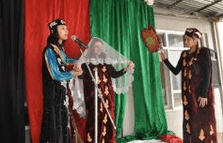On Friday, November 16, youth traveled from Bamyan, Nangarhar, Herat and Juzjan to a cultural festival, called Rainbow, to exhibit the clothing, food, dried fruit, handicrafts, and arts of their province. As the day progressed the participants sang songs, performed local dances, cat-walked in their colorful traditional dresses, and acted out folk stories. An Uzbek girl, wearing her traditional hat, sang Kelen Salam, a song welcoming a new bride to her house. More than ten youth, men and women, performed the Atan, the national dance of Afghanistan. Young men and women made Kabab together and distributed traditional rice to all the guests of the festival. A woman from Bamyan organized the table where she is exhibiting embroidered handkerchiefs knitted table cloths. Young musicians playing the Tanboor and the local to Northeastern Afghanistan drum, zerbaghali, played folkloric tones that led the guests to cheers.
The festival was organized by a youth social activism group, Hadia, and a civil society organization, Road to Equality and Development. Unlike what the mainstream media usually focuses on, Kabul and other big cities of Afghanistan are alive with social and political activism, youth groups and cultural events. Concerts and poetry events happen weekly. Local organizations have taken onto themselves to screen movies and organize lectures that are often attended by both men and women. The walls of Kabul are often covered with posters created by youth groups who advocate for eradicating corruption, ending gender-based violence, or promoting a new kind of patriotism, one that focuses on dedication to equality and progress.
Youth in Jalalabad organize monthly and yearly poetry festivals where political poems are read with passion to crowds of hundreds of people. Men and women in Mazar-e-Sharif have created a graffiti group and several literature groups. The graffiti band has decorated the walls of the city with slogans and drawings against street harassment of women, economic inequality and war. Youth in Herat have organized public campaigns for peace and justice. In Bamyan, a local youth group has created a green park which is located in the middle of the city. In Kabul, youth have organized protests, rallied and events to show support to Afghan National Security Forces.
Recently, Afghan journalists took upon themselves to launch a campaign against rape and violence against women, which has led to the broadcast of PSAs in local Televisions and radios across the country as well as in TV stations with national coverage. Across the country, youth groups advocate for blood donation campaigns, collect clothing and food for refugees and plant trees to resurrect Afghanistan’s lost forests.
Most of these events are organized by idealist volunteers who feel dedicated to creating a new Afghanistan, one where men and women from all ethnic and religious groups are equal. Though their numbers are still small, these youth work tirelessly despite security concerns and lack of resources and support. A very small number of youth have taken the responsibility to rebuild an Afghanistan by bringing change in public mentality and their work has already made impact as their numbers and supporters among people grow. Most campaigns are focused on bringing together youth of different ethnicities and increasing women’s participation in society. The even organized to show support to Afghan police and army, for example, was led by a woman and a man. The peace group in Bamyan has male and female volunteers. Hadia is run by a group of men and women from several ethnic groups. Through their activism, the youth of Afghanistan are advocating for a more equal Afghanistan. Like Rainbow Festival, these youth seek to create a platform where men and women of different social classes and backgrounds are accepted as a valuable part of Afghanistan and showcase the resources that will remain untapped if the country continues to discriminate against women or small ethnic and religious groups.

